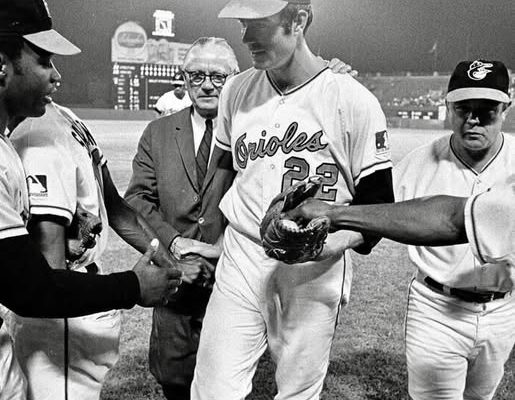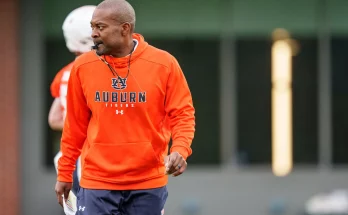Palmer’s Perfection: The Night a 23-Year-Old Orioles Ace Threw a No-Hitter on a Torn Back and Changed the Game Forever
Sometimes baseball gives us stories that sound almost too good to be true. Like a 23-year-old kid returning from injury, tossing a no-hitter just days after being shelved for six weeks with a torn back muscle. That story actually happened — and on August 13, 1969, it became legend. Orioles right-hander Jim Palmer, already known for his smooth delivery and effortless presence on the mound, made history on a summer night at Memorial Stadium, throwing the only no-hitter of his Hall of Fame career against the Oakland Athletics. Baltimore rolled to an 8-0 win, and Palmer rolled right into the record books.
Let’s set the scene: the year is 1969. Baseball is in the midst of change. The American League has just split into two divisions for the first time, creating a new postseason format and an even greater sense of urgency. The Orioles are stacked — power, pitching, defense — and they’re blowing through the East. By the end of Palmer’s no-hitter, they held a ridiculous 14½-game lead in the AL East, making a World Series run look less like a possibility and more like an inevitability.
But for Jim Palmer, things weren’t so certain. He had just returned to the team four days earlier after spending six weeks recovering from a torn lower back muscle. That kind of injury can derail a young pitcher’s development. It can sap velocity, ruin mechanics, and force even the most talented arms into cautious routines. But not Palmer. He didn’t ease back into action. He didn’t need a few starts to shake off the rust. He just showed up, took the ball, and did something only a handful of pitchers have ever done: he threw a no-hitter.
It wasn’t a perfect game — Palmer walked six batters, including three in the ninth inning alone — but it was gritty, dominant, and unforgettable. He struck out eight and baffled an Oakland lineup that featured names like Reggie Jackson and Sal Bando, both big-time bats with no answer for Palmer’s command and deception. He mixed his fastball and curve like a veteran, and even when he lost his control late, he never lost his edge. He finished the job. And when the final out was recorded, Palmer’s teammates rushed the mound, celebrating the rarest kind of pitching performance with the rarest kind of player: a generational talent just scratching the surface of greatness.
That 1969 no-hitter wasn’t just a personal milestone — it was a message. Palmer was more than a promising young pitcher. He was a game-changer. And Baltimore was more than just a good team. They were loaded. They were fierce. They were built to win now.
Palmer’s performance wasn’t limited to the mound, either. He helped his own cause at the plate — something pitchers still did regularly in the pre-DH days — going 2-for-3 with a single, a double, and a walk. Think about that. The guy throws a no-hitter, fans eight batters, battles through injury pain, and also gets on base three times. That’s not just good baseball. That’s heroic stuff.
And maybe that’s the part that gets overlooked when we look back at Palmer’s career. Yes, the three Cy Young Awards. Yes, the 268 career wins. Yes, the flawless 8-0 World Series record. But what made Palmer different was his ability to rise in the biggest moments — even when the odds were stacked against him. Even when his body wasn’t fully ready. Even when control wavered or pressure mounted. That’s what happened on August 13, 1969. The circumstances weren’t ideal, but Palmer didn’t care. He was a gamer before the term became cool.
The no-hitter was Palmer’s eighth win in a row at that point in the season, and he wasn’t done. He would finish 1969 with a 16-4 record and an American League-best .800 winning percentage. And this wasn’t some fluke season. It was the beginning of one of the most consistent and decorated pitching careers in modern baseball history. Palmer would go on to anchor Baltimore’s rotation through three decades — the only pitcher in history to win World Series games in the 1960s, 1970s, and 1980s. But it all really started that night in ’69.
For the Orioles, Palmer’s gem was another high point in a season full of them. They were rolling behind an all-star roster that included Brooks Robinson, Frank Robinson, Boog Powell, and Davey Johnson. They had power and poise. They had defense and discipline. And most of all, they had pitching. Palmer was joined in the rotation by Mike Cuellar and Dave McNally — both 20-game winners that year. It was a rotation that could shut you down three different ways and make opposing hitters look foolish for nine straight innings.
The 1969 Orioles would go on to win 109 games. They dominated the American League East and steamrolled into the postseason, taking the newly minted ALCS with ease. Unfortunately, the miracle New York Mets got the better of them in the World Series — one of the biggest upsets in baseball history. But even that loss couldn’t dampen what the Orioles were building — or the kind of star they had in Palmer.
What stands out most about that no-hitter, looking back more than five decades later, is how symbolic it was of Palmer’s entire career. He wasn’t always flashy. He wasn’t always overpowering. But he was always tough. Always in control when it mattered. Always ready to deliver when the team needed it. And he did it with style. Palmer’s delivery was elegant, smooth, and consistent. His presence on the mound was almost effortless, but his preparation was second to none. He studied hitters. He understood mechanics. And he trusted his stuff.
Fans who were there on August 13, 1969, still talk about the feeling in the stadium that night. The sense that something rare was happening. Palmer had everything working early, and by the fifth or sixth inning, you could feel the buzz. Everyone knew. Baseball fans are funny that way — superstitious, cautious, but instinctive. And that night, even with the walks, even with the drama of the ninth inning, it felt inevitable. Palmer was going to do it. He was going to put the exclamation point on his comeback in the boldest way possible.
And when he did, the baseball world took notice. No-hitters aren’t easy. They require precision, stamina, and nerves of steel. To do it coming off injury? At 23 years old? Against a red-hot team in a pennant race? That’s a different level of greatness.
Palmer didn’t throw another no-hitter after that. He didn’t need to. He became known for his consistency, not just his flash. He was the guy you trusted every five days. The guy you gave the ball to in Game 1 of a playoff series. The guy who, no matter the stakes, showed up and delivered.
By the time he retired, Jim Palmer had cemented himself as an Orioles icon. No other player has ever worn the uniform longer. He spent his entire 19-year career with Baltimore. He was the face of the franchise through eras of change, and he remains a beloved figure in Orioles history.
But August 13, 1969, remains something special. It was the night when promise became reality. The night when a young pitcher battling back pain and rust announced to the baseball world: “I’m here. And I’m for real.”
If you’re an Orioles fan, that no-hitter is more than just a historical footnote. It’s a core memory. It’s a reminder of what made those late-’60s and ’70s teams so special — the talent, the toughness, the belief. And if you’re a baseball fan in general, it’s one of those moments that reminds you why we watch. Why we wait patiently through the dog days of summer for something magical to happen.
Because sometimes, magic shows up in the form of a 23-year-old with a sore back, a wicked curveball, and ice in his veins.
And on August 13, 1969, Jim Palmer delivered that magic in full.



